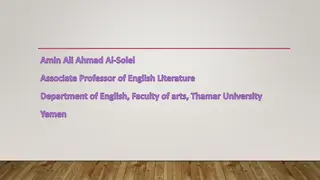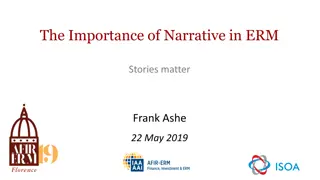Effective Leads for Engaging Narrative Writing
Learn about the SAAD method for crafting compelling leads in narrative writing - Set a scene, Address the audience, Ask a question, and Dialogue. Enhance your storytelling by providing vivid descriptions, engaging your readers directly, and posing thought-provoking questions. Explore examples and techniques to create immersive narratives that captivate your audience from the start.
Download Presentation

Please find below an Image/Link to download the presentation.
The content on the website is provided AS IS for your information and personal use only. It may not be sold, licensed, or shared on other websites without obtaining consent from the author. Download presentation by click this link. If you encounter any issues during the download, it is possible that the publisher has removed the file from their server.
E N D
Presentation Transcript
LEADS FOR NARRATIVE WRITING Ms. Wesh
SAAD Leads stands for: S Set a scene A Address the Audience A Ask a question (not the strongest) D Dialogue
Set a scene: Provide vivid description using sensory details to describe the setting for the reader. The more interesting your description, the more the reader will want to continue reading!
Set a scene: Examples On a summer evening I looked up from dinner, through the open window to the backyard. It was growing dark. Fireflies, by Brinckloe In the night I woke up. I heard something outside like a rustle or a breath. There was a deer under the pear tree. The moon cast a shadow of his antlers on the ground. I went to the door. It was dark. It was still. The night air was warm. Salt Hands, by Chelsea Jane Aragon Chesapeake Bay forms the western boundary of the section of Maryland which is sometimes called Tidewater Maryland, sometimes called the Eastern Shore. Here there are so many coves and creeks, rivers and small streams, that the land areas are little more than heads or necks of land almost surrounded by water.
Address the audience: Start by directing talking to the reader. Tell the reader to do something or use language that gets the readers attention.
Address the audience: EXAMPLES: My full name is Clifford Allyn Abernathy III, after my grandfather, but I leave off the III, the Allyn, and ord. Call me Cliff. Fig Pudding, by Ralph Fletcher Imagine this situation: You are sitting at home watching Spongebob , when you are interrupted by a loud rapping at the door. You struggle to your feet, open the door, and are greeted by two police officers.
Ask a question: Ask a question that will grab the readers attention by getting them interested in the topic. More complex questions will be better for high level readers.
Ask a question: EXAMPLES: Have you ever wondered how you would survive if you found yourself alone in the wilderness? How would you defend yourself against predators? What would you eat? Where would you find water? Have you ever wondered if YOU have what it takes?
Dialogue: Use dialogue to get right into the story and introduce characters. Meaningful dialogue is best. Use dialogue to show character traits right in the beginning of a story so that readers can become interested in the story and want to keep reading.
Dialogue: EXAMPLE: "Jake," Daddy whispers. "It's almost time." I poke my head out of my warm sleeping bag. The air is tingly and cold. Whistling, by Partridge "Where's papa going with that ax?" said Fern to her mother, as they set the table for breakfast. "Out to the hog house," replied her mother, "Some pigs were born last night." "I don't see why he needs an ax," continued Fern, who was only eight. "Well," said her mother, "one of the pigs is a runt. It's very small and weak, and will never amount to anything. So your father has decided to do away with it." "Do away with it?" shrieked Fern. "You mean kill it? Just because it's smaller than the others?" Charlotte's Web, by E.B. White
More LEAD options Snapshot It s ten degrees below zero and the river is frozen a foot thick. It makes snapping sounds like the limbs of trees cracking. A lone figure glides along the black ice, moving towards the city. The only sound is the scraping of each blade as it bites into the river. Describe an Action I ran down to our dock as fast as my legs could carry me, my feet pounding away on the cold wood, hurrying me toward the sound of my dad s panicked voice. Scott! he hollered again. Coming, dad! I gasped, and picked up my speed. Thoughtshot I couldn t imagine what my father could be hollering about already at 7:00 in the morning. I thought hard and fast about what I might have done to get him so riled up. Had he found out about the cigarettes I had hidden in my knapsack? Or the way I talked to my mother the night before, when we got to camp and she asked me to help unpack the car? Before I could consider a third possibility, my dad s voice shattered my thoughts. Scott! Move it! You re not going to believe this! Sound Words Brring! Brring! The sound of the telephone continued to ring insistently throughout the house. Brring! Brring! I couldn t decide. Should I pick up the phone? But what if it was them??
LEAD OPTIONS S Set a scene A Address the Audience A Ask a question (not the strongest) D Dialogue OR S- Snapshot A - Action T - Thoughtshot S - Sound Words

 undefined
undefined





























